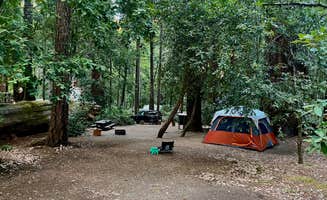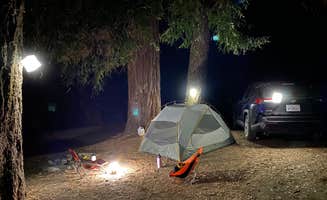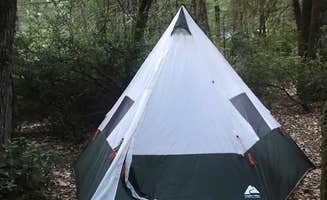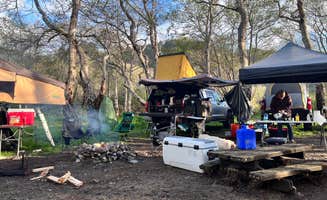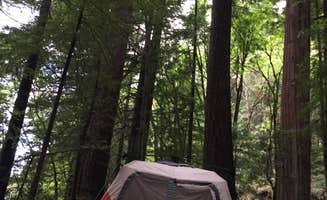The Whitethorn area sits at an elevation ranging from sea level to over 2,000 feet, creating diverse camping environments across King Range National Conservation Area's 68,000 acres. Campers navigate varying terrains from coastal beaches to mountain ridges, with most campgrounds accessible only via unpaved roads. Weather patterns shift dramatically between inland and coastal sites, with fog commonly rolling in during summer mornings at ocean-facing camping sites near Whitethorn, California.
What to do
Beach exploration: Usal Beach offers campers direct access to a secluded stretch of the Lost Coast. "We stayed 10 nights all up the west coast and this was the best tide pooling we had," reports a visitor to Shelter Cove Campground. The black sand beaches provide excellent wildlife viewing opportunities, particularly during low tide.
Mountain biking: Paradise Royale Trail connects directly to Tolkan Campground. "Love this spot! Huge sites, clean pit toilets, and backs right up to the Paradise Royale bike trail and terrain park," notes a camper. The trail system includes over 14 miles of purpose-built single-track ranging from beginner to expert difficulty.
Redwood hiking: Avenue of Giants provides multiple access points for short or extended hikes. "The entire area is incredible and if you have time, take a slow drive through the trees. Ask the rangers for good local hikes and take lots of stops along the turnouts," recommends a visitor to Burlington Campground. Most trails are well-marked with interpretive signs explaining the ecology of these ancient forests.
What campers like
Seclusion factor: Many camping areas offer significant separation from other visitors. "The campground is very clean and quiet. The staff is friendly. Sites are tight, mostly in the sense of getting in and out of them," notes a camper at Benbow KOA. While some locations require more driving to reach, the privacy reward often justifies the effort.
River access: The Eel River provides swimming opportunities during summer months. At Giant Redwoods RV & Cabin Destination, "Our site backed up to the Eel river with Giants redwoods everywhere. The grounds were super clean and quiet. Just hung out at the beach the whole time," explains a visitor. Water levels vary significantly by season, with optimal swimming conditions typically from June through August.
Wildlife encounters: Marine mammals are commonly spotted from coastal campsites. "We went to sleep and woke up to sea lions and Harbor Seals barking," states a camper at Shelter Cove. Inland sites frequently report deer sightings, while early morning visitors to beaches may discover bear tracks in the sand.
What you should know
Road conditions: Access routes to many campgrounds require careful driving. For Usal Beach Campsites, "The road to reach the beach is only about 5 miles long, but it will take you around 45 minutes! We felt like we were driving through Jurassic park to get there." Four-wheel drive is recommended for most unpaved roads in the area, especially during or after rainfall.
Facility limitations: Most camping areas have minimal amenities. "No water or other utilities, pit toilet (bring your own toilet paper) and an $8 fee per night," reports a Tolkan Campground visitor. Even established campgrounds often lack cell service, with limited provisioning options available near camping areas.
Weather variability: Coastal fog commonly impacts visibility and temperatures. A Richardson Grove camper notes, "It got really cold at night and SUPER WINDY (December)." Temperature differences between coastal and inland sites can exceed 20 degrees, making layered clothing essential even in summer months.
Tips for camping with families
Look for enclosed campsites: Richardson Grove State Park Campground offers family-friendly sites with natural boundaries. "The campsites here are enormous and provide plenty of separation from fellow campers. There are many close hikes and swimming in the nearby Eel river," observes one visitor. Sites 1-10 are particularly suitable for families with young children.
Plan beach safety: Coastal beaches have unpredictable conditions. "Bring your water shoes. The river is very rocky!" advises a camper. Tidal charts should be consulted before beach exploration, as rising tides can quickly eliminate return paths along narrow shorelines.
Pack extra supplies: Limited stores mean bringing adequate provisions. "The store sells everything from beach towels and propane to kombucha and puzzles," notes a Richardson Grove visitor regarding the small market across from the campground. However, most camping areas have no nearby purchasing options beyond basic firewood.
Tips from RVers
Site selection priorities: Many campgrounds have challenging access for larger vehicles. At Burlington Campground, "We pulled in at midnight and woke up to beautiful trees we weren't able to see in the dark. It is right next to the road if road noise bothers anyone." RVs exceeding 28 feet may struggle at most Lost Coast camping areas.
Electrical management: Most campgrounds lack hookups. "Tons of shade so don't expect your solar panels to keep your battery charged," warns a Burlington Campground RVer. Generator restrictions apply at most locations, with strict quiet hours enforced particularly at state park campgrounds.
Water conservation: Limited fill stations necessitate careful usage. "Water fill? - Yes, free," confirms a review from Mackerricher State Park, though most camping areas near Whitethorn require bringing all water. Dumping stations are similarly limited, with Shelter Cove and Richardson Grove among the few offering this service.



